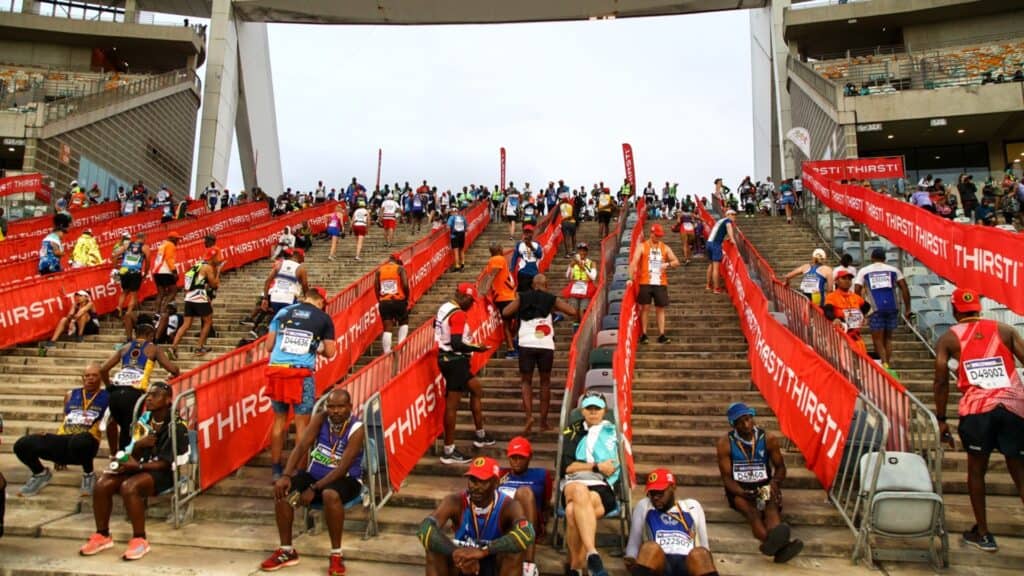Training for the Comrades Marathon demands dedication and careful planning.
Yet, unforeseen circumstances may arise, necessitating adjustments to your training program.
In this guide, we’ll explore how to realign your Comrades Marathon training schedule for optimal performance.
We’ll also delve into common challenges faced by marathoners and explore strategies to overcome them.
Injuries can be a major setback for Comrades Marathon runners, disrupting training schedules and raising doubts about race day performance.
So, we’ll address two common injury-related queries posed by runners preparing for the Comrades Marathon.
Raoul le Roux finds himself sidelined by an injury, having missed three weeks of training.
Despite a solid buildup of 970km since January and ongoing physiotherapy, Raoul wonders if he can still complete the Comrades Marathon.
We offer a sobering perspective, advising against participating if Raoul continues to miss training for another four weeks.
While resting for shorter periods may allow some leeway, prolonged absence significantly compromises fitness and enjoyment on race day.

Gillian’s Challenge
Gillian Innis, having fractured her metatarsal bone last year, faces uncertainty about her readiness for the Comrades Marathon.
Despite clocking 750km since January, Gillian’s lack of marathon distances and endurance-building activities raises concerns about her preparedness.
We emphasize the importance of adequate training volume and long runs in achieving marathon success.
For Gillian, a borderline finisher, a more robust training regimen may be necessary to improve her chances of completing the marathon.
Navigating Tough Decisions
Both Raoul and Gillian grapple with difficult decisions about their marathon participation.
I underscore the importance of realistic self-assessment and thorough preparation.
While the allure of the marathon may tempt runners to push through injuries or insufficient training, prioritizing health and readiness is paramount.
As the race will return in subsequent years, runners are encouraged to focus on optimal recovery and training for future success.
Injuries present significant challenges for marathon runners, requiring careful consideration and adaptation in training plans.
By seeking expert advice, assessing readiness realistically, and prioritizing health and preparation, runners can navigate setbacks effectively and improve their chances of success on race day.
Remember, the marathon journey is as much about resilience and determination as it is about crossing the finish line.
Imagine diligently following your marathon training program, only to suddenly find yourself feeling weaker and more breathless with each run.

Recognizing Signs of Struggle
This scenario, described by a runner named Alex in the podcast, highlights a common challenge faced by many marathoners.
My suggestion is that experiencing fatigue and breathlessness may indicate issues with the training program’s intensity and balance.
In Alex’s case, the combination of training, cross-training, and daily activity may be overwhelming, leading to inadequate recovery and overtraining.
Implementing Adjustments for Recovery
To address these challenges, it’s essential to prioritize recovery and balance in your training regimen. This may involve reducing training frequency, intensity, or incorporating more rest days into your schedule. By allowing your body adequate time to recover, you can prevent burnout and improve overall performance.
While fatigue and breathlessness are often attributed to training-related factors, it’s crucial not to overlook potential underlying health issues. In Alex’s case, persistent breathlessness warrants medical evaluation to rule out cardiovascular concerns. Seeking timely medical advice can help address any potential health risks and ensure safe training practices.
For marathoners facing challenges in their training journey, seeking support from experienced coaches, online communities, and healthcare professionals can provide valuable guidance and assistance.

Navigating Comrades Marathon Training After Injury
In this section, we address a query from Peter Yulie, a runner in the midst of rehabilitation.
Peter shares his best 5km time of 33 minutes and his collaboration with the Sharks Medical Centre, expressing confidence in their support.
With a history of seven Did Not Finish (DNF) instances at the Comrades Marathon, Peter seeks guidance on selecting the appropriate training program moving forward.
Choosing the Right Path: Finishers vs. Bronze Program
Peter currently follows the Finishers Program but contemplates transitioning to the Bronze Program.
I analyzed Peter’s situation, emphasizing the need to consider his injury susceptibility and current fitness level. Despite his admirable 5km time, Peter’s injury history warrants caution, suggesting a conservative approach to training.
I also advised Peter to adhere to the Finishers Program, prioritizing injury prevention and gradual progression.
While Peter’s ultimate goal may be to qualify at the Postnet Marathon and transition to the Bronze Program, I underscored the importance of addressing immediate concerns.
By focusing on injury-free running and gradually improving his 5km time, Peter can lay a solid foundation for future training endeavors.
Peter’s journey toward Comrades Marathon success requires a delicate balance between rehabilitation and training.
By aligning his program with his current capabilities and injury status, Peter can navigate the challenges of injury recovery while maintaining his long-term goals.
Imagine you’ve been diligently following your marathon training plan when suddenly, you find yourself needing to adjust your schedule due to an earlier race date. How do you navigate this situation without compromising your preparation?
Proactive Approach to Adjustment:
Expert advice suggests taking a proactive approach to recalibrating your training program. Start by thoroughly reviewing your entire training schedule and determining the necessary adjustments based on the new race date. It’s crucial to act swiftly to maintain momentum and ensure you’re adequately prepared for race day.
Making Strategic Adjustments:
Consider the example of a runner who finds themselves with a marathon scheduled a week earlier than anticipated. To accommodate this change, it’s advisable to skip the current week of training. By doing so, you prioritize tapering and allow for proper recovery leading up to the race, thereby optimizing your performance.
Emphasizing Tapering and Recovery:
Tapering is a critical aspect of marathon preparation, allowing your body to rest and recover before the big race. By adjusting your training schedule early and prioritizing tapering, you can ensure you arrive at the starting line feeling fresh and ready to perform at your best.
Related: Marathon Tapering Method GUARANTEED To Have You At Your BEST Come Race Day
Key Takeaways for Marathoners:
- Be prepared to adapt your training schedule in response to changes in race dates or unforeseen circumstances.
- Take a proactive approach to adjustment, reviewing your entire training plan and making necessary changes promptly.
- Prioritize tapering and recovery to optimize your performance on race day and minimize the risk of injury or fatigue.
Navigating changes to your marathon training schedule requires careful consideration and planning. By taking a proactive approach, prioritizing tapering and recovery, and seeking support when needed, you can effectively adjust your training program and set yourself up for success on race day.



Comments are closed.